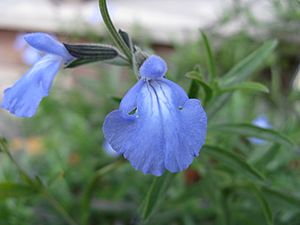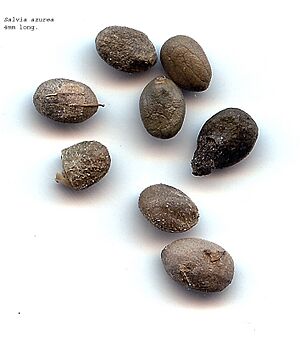Azure blue sage facts for kids
Quick facts for kids Azure blue sage |
|
|---|---|
 |
|
| Scientific classification | |
| Genus: |
Salvia
|
| Species: |
azurea
|
Salvia azurea, also known as azure blue sage or blue sage, is a beautiful plant. It's a type of Salvia that grows year after year. You can find it naturally in Central and Eastern North America.
What Does it Look Like?
This plant has thin, straight stems that can grow up to 6 feet (1.8 m) tall. Its leaves are green and narrow, with pointed ends. They can be smooth or slightly furry. The leaves attach to the stems with small stalks called petioles, about 0.4 inches (1.0 cm) long. This plant does not have leaves at its base.
The flowers are usually blue, but sometimes they can be white. They are about 1⁄4 to 1⁄2 inch (6.4 to 12.7 mm) long. You can see them from summer to autumn. They grow in spikes near the ends of the stems. The part that holds the flower, called the calyx, is shaped like a tube or bell and is furry.
There are two main types, or varieties, of Salvia azurea. They are Salvia azurea var. azurea (azure sage) and Salvia azurea var. grandiflora (Pitcher sage).
In the wild, the stems of Salvia azurea can be long and sometimes fall over. This happens because the flowers make the stems heavy. When people grow this plant, they sometimes trim the stems. This helps the plant grow more branches. It also keeps the plant from growing too tall and falling over.
Where Does it Grow?
You can find Salvia azurea across a wide area. It grows from Utah in the west all the way to Connecticut in the east. It also grows from Minnesota in the north down to Florida in the south.
The Salvia azurea var. azurea type is usually found in the eastern and southeastern parts of this area. The Salvia azurea var. grandiflora type is found more in the west and northwest. In some places, like Illinois, this plant is rare. It is listed as a threatened species there.
You can often see Salvia azurea growing wild. It likes to grow on roadsides, in open grassy areas called glades, and in prairies. It also grows in savannas, fields, and pastures. This plant prefers dry, sunny places. It can grow in different types of soil, like clay, gravel, and loam. If the soil is too wet, the plant will still grow. However, it might fall over more easily.
Different Types of Azure Sage
Here are the known varieties of Salvia azurea:
- Salvia azurea var. azurea - This is often called azure sage.
- Salvia azurea var. grandiflora - This type is known as Pitcher sage.
- Salvia azurea var. grandiflora 'Nekan' - This is a special type of Pitcher sage. It was chosen in 1977 for growing better and more evenly. It was developed by plant centers in Kansas and Nebraska.
See also
 In Spanish: Salvia azurea para niños
In Spanish: Salvia azurea para niños


